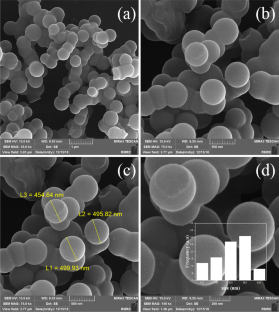Applied Physics A ( IF 2.7 ) Pub Date : 2024-04-08 , DOI: 10.1007/s00339-024-07465-z Maziar Marandi , Sana Alejaber , Farkhondeh Mirahmadi

|
In this research TiO2 hollow spheres (HSs) were prepared using hydrothermally grown carbon spheres as the templates through a sol gel, liquid phase deposition method followed by an annealing process. Then they were introduced to another hydrothermal process for a controlled growth of the TiO2 branches on their surface. The synthesized branched HSs were deposited on a nanocrystalline TiO2 sublayer and formed an effective light scattering film in the photoelectrode of corresponding quantum dot sensitized solar cells (QDSCs). This could majorly increase the light traveling path inside the light absorbing quantum dots sensitizing layers and increase the power conversion efficiency. Three types of photoelectrodes including TiO2 NCs/CdSeTe sensitizing QDs/ZnS, TiO2 NCs/TiO2 HSs/CdSeTe QDs/ZnS and TiO2 NCs/TiO2 branched HSs/CdSeTe QDs/ZnS were fabricated and applied in QDSCs. The alloyed CdSeTe quantum dots (QDs) were synthesized through organometallic approach in high temperature with an absorption edge located around 800 nm. The corresponding bandgap energy is consequently appropriate for light absorption in visual-near IR region. The selection of hyperbranched TiO2 HSs with different dimensions of branches was so carried out to make the maximum QDs loading. Based on the findings, thepower conversion efficiency of the QDSC with TiO2NCs/TiO2 HSs/CdSeTe photoanode was measured about 4.8%. This efficiency was enhanced to 6.1% for the improved cell with a TiO2 NCs/branched TiO2 HSs/CdSeTe QDs/ZnS photoanode including light scatterer branched structures prepared at 3 h of the second hydrothermal branching stage. The reason was attributed to the higher level of light scattering and better QDs loading in modified photoanode due to shape and higher surface area of the branched TiO2 HSs.
Graphical Abstract
中文翻译:

超支化 TiO2 空心球的简便合成和应用,以提高 CdSeTe 量子点敏化太阳能电池的功率转换效率
本研究以水热生长的碳球为模板,通过溶胶凝胶、液相沉积法和退火工艺制备了TiO 2空心球(HS)。然后将它们引入另一种水热工艺,以控制其表面TiO 2分支的生长。合成的支化HS沉积在纳米晶TiO 2亚层上,并在相应的量子点敏化太阳能电池(QDSC)的光电极中形成有效的光散射膜。这可以大大增加光吸收量子点敏化层内的光传播路径并提高功率转换效率。制备了TiO 2 NCs/CdSeTe敏化QDs/ZnS、TiO 2 NCs/TiO 2 HSs/CdSeTe QDs/ZnS和TiO 2 NCs/TiO 2支化HSs/CdSeTe QDs/ZnS三种光电极并应用于QDSC。通过有机金属方法在高温下合成了合金化的 CdSeTe 量子点(QD),其吸收边位于 800 nm 左右。因此,相应的带隙能量适合于可见光-近红外区域的光吸收。选择具有不同支链尺寸的超支化TiO 2 HS,以实现最大的QD负载。基于该研究结果,测得具有TiO 2 NCs/TiO 2 HSs/CdSeTe光阳极的QDSC的功率转换效率约为4.8%。对于具有TiO 2 NC/支化TiO 2 HS/CdSeTe QD/ZnS光阳极(包括在第二水热支化阶段3小时制备的光散射体支化结构)的改进电池,该效率提高至6.1% 。原因是由于支化TiO 2 HS的形状和更高的表面积,改性光电阳极中的光散射水平更高,量子点负载更好。



























 京公网安备 11010802027423号
京公网安备 11010802027423号